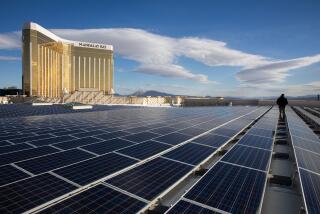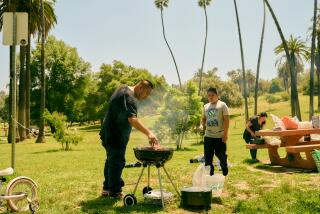Well Done in the Sun
- Share via
It’s a hot summer afternoon in energy-parched California, but that’s not stopping Eleanor Shimeall from baking a cake, even in Borrego Springs. Up north, in sun-drenched Davis, Rick Palkovic is cooking sweet corn. And as the Southland simmers, Doug Edwards coolly lifts a loaf of homemade beer bread from his oven in Cerritos.
These cooks aren’t worried about heating up their kitchens, nor does the threat of rolling blackouts faze them. They are solar cooks, and although their numbers may be few, their ovens are fired by a force mightier than the power company: Old Sol himself.
Solar cooking has been around since at least 1767, when Swiss naturalist Horace de Saussure tapped the sun’s rays to cook fruit in an experiment. Today groups such as Rotary International tout its use in developing countries where firewood and clean water are scarce. And, of course, science teachers and environmentalists love it.
While solar cooking has not exactly settled into the mainstream, the hard-core insist that California’s energy crunch could change that.
When a local paper did a story on solar cooking recently, the Sacramento office of Solar Cookers International sold out of solar cookbooks, cooking pots and the fold-up “CooKit” solar panel cooker that SCI invented. The group, co-founded by Shimeall and her husband, Clark, is a major proponent of the use of the process in developing nations and a global clearinghouse for solar cooking (https://www.solarcooking.org).
“I think people are looking for any idea that will save energy, and this has a big potential to do that,” says Lorraine Anderson, an environmentalist and coauthor with Palkovic of a solar cookbook, “Cooking With Sunshine” ($12), sold through SCI. “You not only save on the cost of using the stove, but you’re not heating up your house, so you save on air-conditioning costs.”
Just by solar cooking on weekends and holidays with his portable outdoor oven, Jim Arwood of Phoenix calculates that his family shaves about $40 from their electric bill over the summer.
There’s also a big “wow!” factor. Picture this: You put food in a box in your backyard in the morning; you return at the end of the day and dinner’s done.
“This is the most fantastic thing!” Shimeall recalls saying when she saw a solar box cooker demonstration at a League of Women Voters meeting in Stockton 20 years ago. Immediately hooked, she paid $50 for a cardboard cooker and has since prepared everything from whole turkeys to ice cream, solar-style.
Along the way, she wrote “Eleanor’s Solar Cookbook”($10), with proceeds going to SCI. (Many in the movement are evangelical about solar cooking, and it sometimes seems that everyone has either a Web site or a cookbook.)
Today, Shimeall cooks daily using a 14-year-old box cooker on wheels she keeps on the edge of the veranda. Sometimes she has four pots going in the outdoor oven; sometimes it’s just a hard-boiled egg for an egg salad sandwich. Palkovic and Edwards also use their solar ovens daily in the solar season, which runs from March to October in Northern California cities such as Davis, but is pretty much year-round in Southern California.
They’d have more company if people realized how easy solar cooking is, they insist.
You can solar cook just about anywhere in the U.S. except Alaska, Palkovic says. Altitude has nothing to do with it; it’s strictly a matter of latitude. If you live between 60 degrees north latitude and 60 degrees south latitude, you can solar cook. The closer you are to the equator, the more solar cooking days you have.
But what nature giveth, nature taketh away. Clouds, puffy or otherwise, are the bane of solar cooking. They reduce solar energy and increase cooking time. A really cloudy day can drive a solar chef right back into the kitchen. Enthusiasts, however, say they don’t mind. They are still saving energy in the long run.
“Most people are kind of reluctant to fool with this because they think there’s a trick to it, but it’s the easiest thing in the world,” says Edwards, who promotes solar cooking at https://www.home.earthlink.net/~drduggee/solar.htm. He has built a dozen homemade solar cookers and uses a commercially made solar oven as well.
To get started, you need a spot in a backyard or on the patio that gets at least four hours of sunlight a day. You can make your own solar oven--which should face south--of cardboard boxes or plywood and a bit of glass, aluminum foil and glue; buy a $20 CooKit, which reflects sunlight into a dark pot enclosed in a clear plastic bag; or buy a commercially made sun oven for about $250.
There’s even a built-in version where the oven sticks out of the house like a window box and the cook has indoor access. The Kerr-Cole Sustainable Living Center in Taylor, Ariz., has construction plans for the built-in on its Web site, https://www.accessone.com/~sbcn/walloven.htm.
For cooking, you need black pots to absorb direct and reflected sunlight that enters the oven through the glass or plastic top and turns into heat energy. The best pots are wide and shallow and made of thin metal in black or dark blue enamel finish like graniteware.
Palkovic’s favorite pot, though, is made of two 9-inch, nonstick cake tins. Food goes in one, the other becomes a lid. Document clamps from the local office supply store hold the tins together. Edwards bakes bread in a 32-ounce juice can sprayed with black barbecue grill paint, while Shimeall tents a piece of black-painted aluminum foil over the cake she’s baking to speed up the process.
Solar cooks say you can cook just about everything, from “Apple Solar Plexis” (apple cake) to “Solarque Chicken.” Most slow-cooker recipes will also work.
Because food is cooked in covered pots--except for roasting nuts and some baking--meat and poultry is more moist and vegetables more flavorful, solar cooks say. Root vegetables are popular solar dishes, along with lasagna and fish. Dark foods, like chocolate cake, cook faster than light ones. Because food doesn’t get baked on, cleanup is easier.
There are drawbacks. Stir-frying and sauteing are out because solar ovens don’t have “instant hot,” as Shimeall puts it, and sauces won’t thicken because you’re cooking in covered pots. The U.S. Department of Agriculture, which has taken no official position on solar cooking, advises all cooks to use food thermometers to make sure food reaches the temperatures at which disease-causing microorganisms are killed. (For a temperature chart, go to https://www.fsishttps://.usda.gov/oa/thermy/kitchen.htm.) It is not safe to leave cooked food more than three or four hours in an unheated solar oven, and certainly not overnight.
Still, solar cooks find something magical about preparing meals with sunshine. Says solar cookbook author Anderson: “It only takes a few brave souls trying something that makes a whole lot of sense before people say, ‘Yeah, I can do that too.”’
More to Read
Eat your way across L.A.
Get our weekly Tasting Notes newsletter for reviews, news and more.
You may occasionally receive promotional content from the Los Angeles Times.










